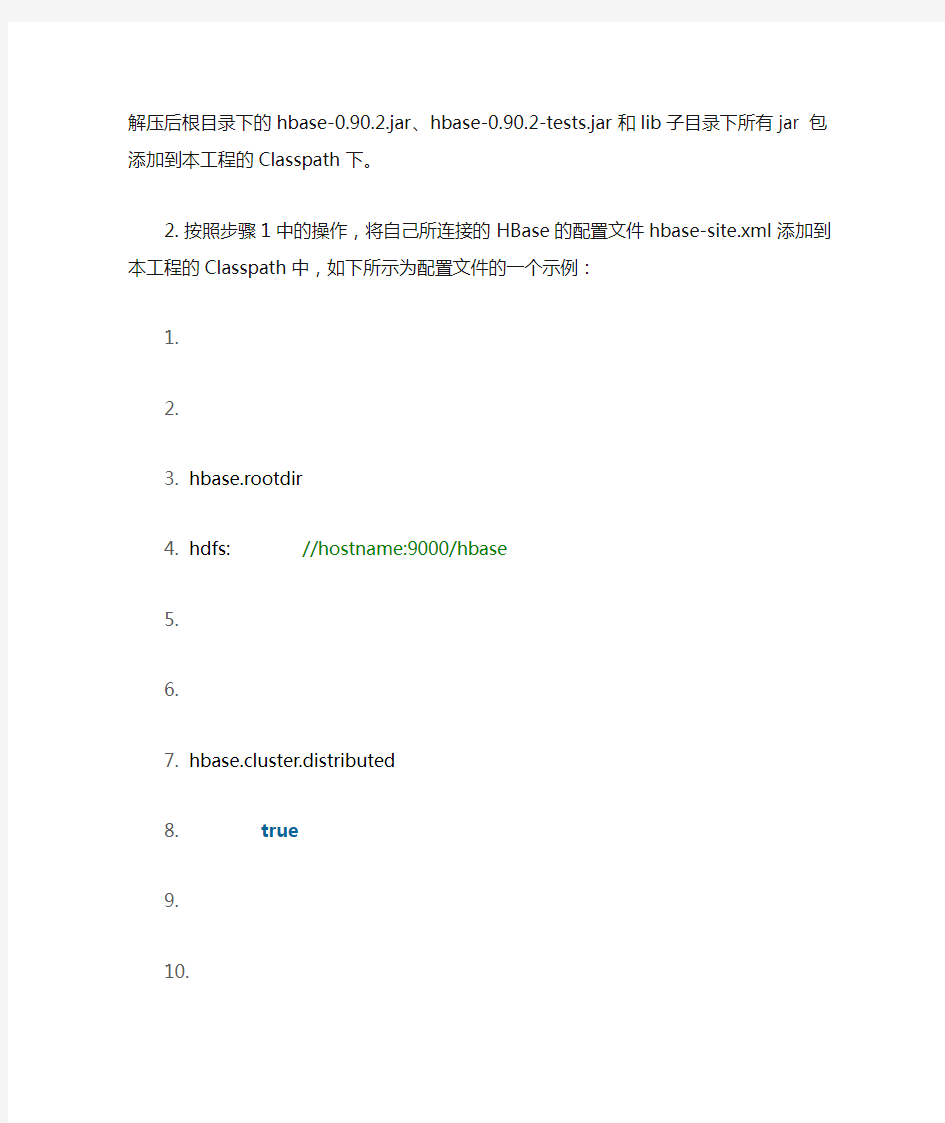基于Java的HBase客户端编程


基于Java的HBase客户端编程
本文以HBase 0.90.2为例,介绍如何在Windows系统,Eclipse IDE集成环境下,使用Java 语言,进行HBase客户端编程,包含建立表、删除表、插入记录、删除记录、各种方式下的查询操作等。
AD:
本文以HBase 0.90.2为例,介绍如何在Windows系统,Eclipse IDE集成环境下,使用Java语言,进行HBase客户端编程,包含建立表、删除表、插入记录、删除记录、各种方式下的查询操作等。
1. 准备工作
1.下载后安装jdk包(这里使用的是jdk-6u10-rc2-bin-b32-windows-i586-p-12_sep_2008);
2.下载eclipse,解压到本地(这里使用的是eclipse-java-helios-SR2-win32);
3.下载HBase包,解压安装包到本地(这里使用的是hbase-0.90.2)。
2. 搭建开发环境
1.运行Eclipse,创建一个新的Java工程“HBaseClient”,右键项目根目录,选择“Properties”
->“Java Build Path”->“Library”->“Add External JARs”,将HBase解压后根目录下的
hbase-0.90.2.jar、hbase-0.90.2-tests.jar和lib子目录下所有jar 包添加到本工程的
Classpath下。
2.按照步骤1中的操作,将自己所连接的HBase的配置文件hbase-site.xml添加到本工程的
Classpath中,如下所示为配置文件的一个示例:
1.
2.
3.
4.
5.
6.
7.
8.
9.
10.
11.
12.
13.
14.
15.
16.
17.
18.
3.下面可以在Eclipse环境下进行HBase编程了。
3. HBase基本操作代码示例
3.1 初始化配置
1.private static Configuration conf = null;
2./**
3. * 初始化配置
4. */
5.static {
6. conf = HBaseConfiguration.create();
7.}
3.2 创建表
1./**
2. * 创建表操作
3. * @throws IOException
4. */
5.public void createTable(String tablename, String[] cfs) throws IOExcep
tion {
6. HBaseAdmin admin = new HBaseAdmin(conf);
7.if (admin.tableExists(tablename)) {
8. System.out.println("表已经存在!");
9. }
10.else {
11. HTableDescriptor tableDesc = new HTableDescriptor(tablename);
12.for (int i = 0; i < cfs.length; i++) {
13. tableDesc.addFamily(new HColumnDescriptor(cfs[i]));
14. }
15. admin.createTable(tableDesc);
16. System.out.println("表创建成功!");
17. }
18.}
3.3 删除表
1./**
2. * 删除表操作
3. * @param tablename
4. * @throws IOException
5. */
6.public void deleteTable(String tablename) throws IOException {
7.try {
8. HBaseAdmin admin = new HBaseAdmin(conf);
9. admin.disableTable(tablename);
10. admin.deleteTable(tablename);
11. System.out.println("表删除成功!");
12. } catch (MasterNotRunningException e) {
13. e.printStackTrace();
14. } catch (ZooKeeperConnectionException e) {
15. e.printStackTrace();
16. }
17.}
3.4 插入一行记录
1./**
2. * 插入一行记录
3. * @param tablename
4. * @param cfs
5. */
6.public void writeRow(String tablename, String[] cfs) {
7.try {
8. HTable table = new HTable(conf, tablename);
9. Put put = new Put(Bytes.toBytes("rows1"));
10.for (int j = 0; j < cfs.length; j++) {
11. put.add(Bytes.toBytes(cfs[j]),
12. Bytes.toBytes(String.valueOf(1)),
13. Bytes.toBytes("value_1"));
14. table.put(put);
15. }
16. } catch (IOException e) {
17. e.printStackTrace();
18. }
19.}
3.5 删除一行记录
1./**
2. * 删除一行记录
3. * @param tablename
4. * @param rowkey
5. * @throws IOException
6. */
7.public void deleteRow(String tablename, String rowkey) throws IOExcept
ion {
8. HTable table = new HTable(conf, tablename);
9. List list = new ArrayList();
10. Delete d1 = new Delete(rowkey.getBytes());
11. list.add(d1);
12. table.delete(list);
13. System.out.println("删除行成功!");
14.}
3.6 查找一行记录
1./**
2. * 查找一行记录
3. * @param tablename
4. * @param rowkey
5. */
6.public static void selectRow(String tablename, String rowKey)
7.throws IOException {
8. HTable table = new HTable(conf, tablename);
9. Get g = new Get(rowKey.getBytes());
10. Result rs = table.get(g);
11.for (KeyValue kv : rs.raw()) {
12. System.out.print(new String(kv.getRow()) + " ");
13. System.out.print(new String(kv.getFamily()) + ":");
14. System.out.print(new String(kv.getQualifier()) + " ");
15. System.out.print(kv.getTimestamp() + " ");
16. System.out.println(new String(kv.getValue()));
17. }
18.}
3.7 查询表中所有行
1./**
2. * 查询表中所有行
3. * @param tablename
4. */
5.public void scaner(String tablename) {
6.try {
7. HTable table = new HTable(conf, tablename);
8. Scan s = new Scan();
9. ResultScanner rs = table.getScanner(s);
10.for (Result r : rs) {
11. KeyValue[] kv = r.raw();
12.for (int i = 0; i < kv.length; i++) {
13. System.out.print(new String(kv[i].getRow()) + " ");
14. System.out.print(new String(kv[i].getFamily()) + ":");
15. System.out.print(new String(kv[i].getQualifier()) + "
");
16. System.out.print(kv[i].getTimestamp() + " ");
17. System.out.println(new String(kv[i].getValue()));
18. }
19. }
20. } catch (IOException e) {
21. e.printStackTrace();
22. }
23.}
